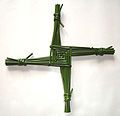
Brigid's cross
Encyclopedia

Irish language
Irish , also known as Irish Gaelic, is a Goidelic language of the Indo-European language family, originating in Ireland and historically spoken by the Irish people. Irish is now spoken as a first language by a minority of Irish people, as well as being a second language of a larger proportion of...
) Cros Bríde, Crosóg Bríde or Bogha Bríde, though not recorded before the seventeenth century, is an Irish
Ireland
Ireland is an island to the northwest of continental Europe. It is the third-largest island in Europe and the twentieth-largest island on Earth...
symbol. Though a Christian symbol, it possibly derives from the pagan
Paganism
Paganism is a blanket term, typically used to refer to non-Abrahamic, indigenous polytheistic religious traditions....
sunwheel
Sun cross
The sun cross, also known as the wheel cross, Odin's cross, or Woden's cross, a cross inside a circle, is a common symbol in artifacts of the Americas and Prehistoric Europe, particularly during the Neolithic to Bronze Age periods.-Stone Age:...
. It is usually made from rushes
Juncus
Juncus is a genus in the plant family Juncaceae. It consists of some 200 to 300 or more species of grassy plants commonly called rushes...
or, less often, straw
Straw
Straw is an agricultural by-product, the dry stalks of cereal plants, after the grain and chaff have been removed. Straw makes up about half of the yield of cereal crops such as barley, oats, rice, rye and wheat. It has many uses, including fuel, livestock bedding and fodder, thatching and...
. It comprises a woven square in the centre and four radials tied at the ends.
Brigid's crosses are associated with Brigid of Kildare
Brigid of Kildare
Saint Brigit of Kildare, or Brigit of Ireland , nicknamed Mary of the Gael is one of Ireland's patron saints along with Saints Patrick and Columba...
, who is venerated as one of the patron saint
Saint
A saint is a holy person. In various religions, saints are people who are believed to have exceptional holiness.In Christian usage, "saint" refers to any believer who is "in Christ", and in whom Christ dwells, whether in heaven or in earth...
s of Ireland. The crosses are traditionally made on 1 February, which in the Irish language
Irish language
Irish , also known as Irish Gaelic, is a Goidelic language of the Indo-European language family, originating in Ireland and historically spoken by the Irish people. Irish is now spoken as a first language by a minority of Irish people, as well as being a second language of a larger proportion of...
is called Lá Fhéile Bhríde (St. Brigid's feast day), the day of her liturgical celebration.
Many rituals are associated with the making of the cross
Cross
A cross is a geometrical figure consisting of two lines or bars perpendicular to each other, dividing one or two of the lines in half. The lines usually run vertically and horizontally; if they run obliquely, the design is technically termed a saltire, although the arms of a saltire need not meet...
es. It was traditionally believed that a Brigid's Cross protects the house from fire and evil. It is hung in many Irish and Irish-American kitchens for this purpose.
Brigid's cross (sometimes stylized) was used to represent Telefís Éireann and RTÉ 1 (later RTÉ One); in 1961 to 1987 and 1993 to 2000.
Story of the Christian St. Brigid and her cross
In Christian religion, St. Brigid and her cross are linked together by a story about her weaving this form of cross at the death bed of either her father or a pagan lord, who upon hearing what the cross meant, asked to be baptized. One version goes as follows:A pagan chieftain from the neighbourhood of Kildare was dying. Christians in his household sent for Brigid to talk to him about Christ. When she arrived, the chieftain was raving. As it was impossible to instruct this delirious man, hopes for his conversion seemed doubtful. Brigid sat down at his bedside and began consoling him. As was customary, the dirt floor was strewn with rushes both for warmth and cleanliness. Brigid stooped down and started to weave them into a cross, fastening the points together. The sick man asked what she was doing. She began to explain the cross, and as she talked, his delirium quieted and he questioned her with growing interest. Through her weaving, he converted and was baptized at the point of death. Since then, the cross of rushes has existed in Ireland.

